
Using CCTV and dash cam footage as evidence in personal injury claims
Proving who is at fault for a road traffic collision can be one of the most challenging aspects of a personal injury claim. Recollections of what exactly happened can vary, especially when those involved have been subject to high levels of emotional stress and trauma. Here we look at how to obtain and use dash cam and CCTV footage to help with your claim.
Where there are no independent witnesses, footage from CCTV and vehicle-mounted cameras (‘dash cams’) can be invaluable in assisting clear up factual disputes. It can help establish the cause of a collision, identify the parties involved, and provide a clear picture of the events leading up to the collision itself.
Use of footage
CCTV is becoming routinely available in the UK, be that static cameras from a council, shop or premises, or dash cams. Many people are also installing video doorbells at their homes to make them feel safe.
It’s no surprise then that dash cams are becoming more and more popular. Dash cams sit on a vehicle’s dashboard or are fixed to the windscreen, and you can also get rear-facing dash cams as well. In most cases, a dash cam automatically turns on when a vehicle is started and records everything that happens on the road in front of the vehicle (or behind) whilst it is in use.
How to obtain dash cam footage
If you were involved in a collision and your vehicle was equipped with a dash cam, you should keep the footage of the event safe and provide it to the police so it can be utilised as evidence in your case.
If you do not have a dash cam installed in your vehicle, you might be able to collect footage from other motorists in the area or from the CCTV cameras of the local authority or local businesses. CCTV ownership details can usually be found on a sign attached to the camera or nearby.
A company is not obligated to retain CCTV footage, but you are entitled to footage in which you appear. Under government guidance you have the right to request footage of yourself through a Subject Access Request. The organisation must provide the footage within 30 days.
Time is of the essence here as many cameras do not hold footage for longer than a matter of weeks or months. It is best not to rely solely on the police to obtain this footage as often by the time they do so it no longer exists.
Proving your claim with dash cam or CCTV footage
CCTV and dash cam footage can be used as evidence in circumstances where the court has to decide who was at fault for a collision. The owner of the footage has to give permission for it to be used.
This evidence can be particularly compelling in cases where someone has died or been seriously injured in a collision, and cannot give their own account of what occurred. The footage effectively acts as a silent and impartial witness, and can be extremely valuable evidence for parties (including the police, insurers and solicitors) to help reconstruct and understand the events leading up to the accident.
CCTV footage can also be scientifically analysed far beyond simply seeing what happened on camera. This involves meticulous attention to detail and accurate utilisation of specialist skills. Accident reconstruction companies are routinely called upon to calculate a vehicle’s speed or, for example, to position a large goods vehicle and a pedal cycle to establish what could be seen by the driver in the mirrors.
Disadvantages of using dash cam or CCTV footage in a personal injury claim
There can be drawbacks to submitting dashcam or CCTV evidence. This is particularly the case if the footage doesn’t support your recollection of the events leading up to the collision, or provides a different perspective as to what happened.
Whilst a conflict between your evidence and that of the footage may cause your claim to fail, it is nevertheless relevant and important evidence. It is often possible that both parties contributed to the events leading to a collision, in which case the footage will be useful to determine how much responsibility each party bears for the accident (known legally as ‘contributory negligence’.)
What to do next
If you have been injured in a road traffic collision you can speak to a specialist personal injury solicitor who deals with road traffic collision claims in confidence to see whether you have a personal injury claim.
If you do have a claim and would like to pursue this then they will be able to put your mind at rest in relation to the legal process and what will be expected of you as a claimant. A successful legal claim could help you get your life back on track.










